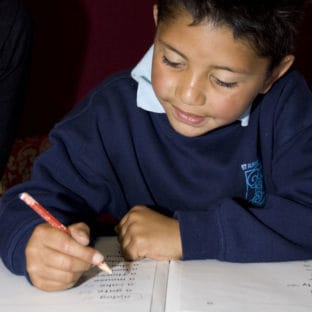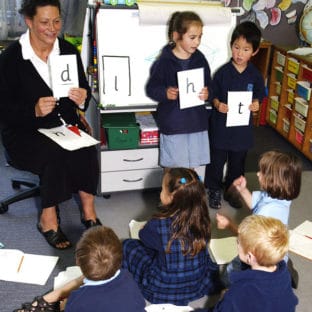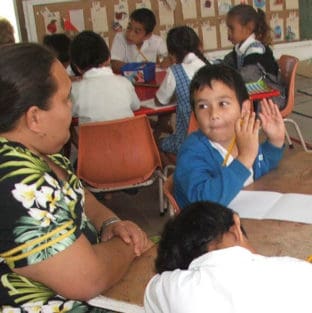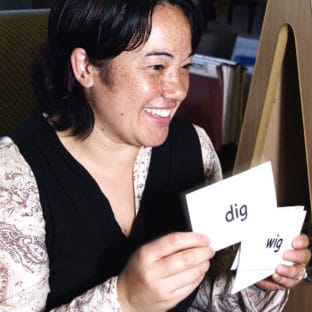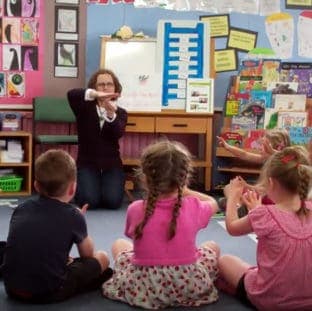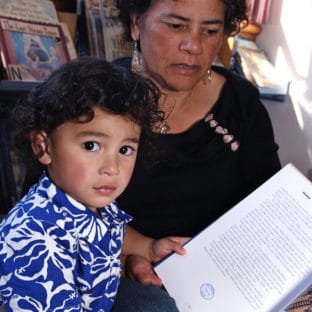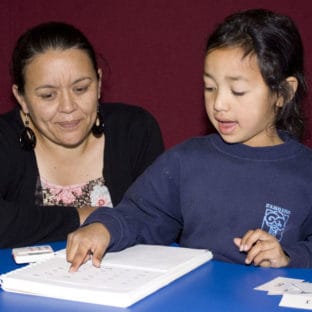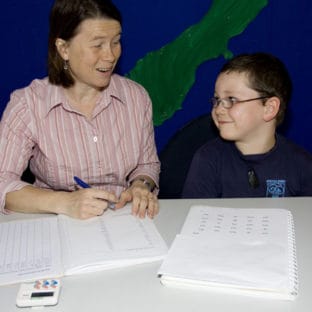Frequently asked questions
General
When should children be taught phonics?
Hearing rhymes and rhythm and learning to hear and discriminate sounds (vital phonic skills) should start at birth. In learning environments, the optimum time to teach phonics is from ages 4-7. Ideally, children should have successfully completed Stage 1 (learning how to hear and discriminate sound) before starting school. The subsequent 6 stages can then be taught in the following two years. Older learners who are low level readers will also need phonics.
Should I replace my existing literacy programme with phonics?
No. Learners need a range of strategies that they can orchestrate together. Phonics is just one strategy children can use to help them read and write. It is a low-level strategy -one that they will not need to use much when they are able and confident readers and writers. Continue to ensure that your learners are offered a rich and balanced literacy programme with explicit phonics teaching as a small but integral part of their early literacy development.
Instead of explicit phonics lessons, isn’t it better to embed the phonics in their reading and writing and look for opportunities to teach it as they arise naturally?
Some children manage well with phonics being taught as it arises in their reading and writing. However, many children don’t. Research and experience has shown that for many children, especially boys, children from lower economic groups and those with English as a second language explicit teaching of phonics is necessary. Further, waiting for opportunities for the teaching of phonics to come up in their reading and writing is inconsistent and means that children can miss out on vital skills and knowledge that have not arisen. Furthermore, laborious attempts to make phonics ‘fit’ in the reading can put children off the story and lose meaning. By teaching the children the phonics skills they need outside of reading, the teacher’s role is then to encourage transfer, rather than try to teach everything all at once in the story..
Should children learn phonics first before being taught to read?
Many pro phonics teachers say that we should teach phonics first before starting guided reading. I think that makes phonics too much the focus and deprives children of opportunities to learn the other three strategies. It’s important to start guided reading straight away.
New Entrants can cope well with learning phonics and graphic knowledge side by side. Guided reading gives them immediate opportunities to try out the strategies we are teaching them in their own reading. At Stage 2, which they start as soon as they begin school, they can get their mouths ready for the first sound of any unknown word and combining that strategy with the picture or context cue is usually enough to help them predict the unknown word correctly whilst also teaching them how to orchestrate two strategies.
In terms of when to teach high frequency words, as with phonics, have a set time to teach them in your daily literacy programme. It should be a much shorter lesson than phonics, just a few minutes using word charts, flash cards and songs. Then transfer the learning straight away to shared/guided reading/writing. In your planning, ensure there are opportunities for transfer and that the high frequency word will appear in the story you are reading and writing that day.
Should children learn to read new words by phonics alone?
When New Entrants come into school, start teaching the phonics stages from day one, but also at the same time teach high frequency words through memorising. In this way, the brain is learning in two different ways (operating both upper and lower circuits). New Entrants need to develop both of the word level strategies (phonics and graphic knowledge). They need to develop two ways of learning to read words: both phonetically and by memorising the graphic patterns. High frequency words usually do not lend themselves well to phonetic learning anyway and these are the words children should learn by sight, rather than by sounding out. By the time the average New Entrant is ready to blend phonemes to read new words (three months after starting school) she could have already learnt at least 20 high frequency words and be reading quite a variety of little books.
Children with difficulties
My pupil has dyslexia. Will phonics be helpful?
Yes. The major difficulty for dyslexics in literacy is phonological weakness. Phonics is harder for dyslexics, but they will need it to be successful readers and writers. Ensure children with dyslexia have explicit phonics teaching and ongoing regular Stage 1 phonological awareness activities (especially rhyming). Lack of fluency is another difficulty for learners with dyslexia. Practise fluency with familiar word flashcards and word speed writing activities.
I’m teaching Year 4 and there are a few children in my class who cannot sound out. Is it too late to introduce phonics for them?
No. These children will certainly benefit from learning phonics skills. However, it is generally harder teaching phonics to older children, especially those who know they are behind, as they will have more confusion about what they can hear and see once they can read and write. Teach carefully, ensuring children are able to participate fully in each step before progressing to the next. In particular, ensure they can hear read and write the short vowel sounds.
There are quite a few children in my New Entrant class who have difficulties with rhyme and rhythm. It’s going to take some time for them to learn this. Should I delay Stage 2 until they can rhyme and hear rhythm?
You are right to be concerned about children who cannot rhyme or hear rhythm. These are vital phonics skills. However, you also need to start Stage 2 so that they are not further delayed in their reading and writing. You could start each Stage 2 lesson with a 3-4 minute Stage 1 activity, using these as a warm-up for the Stage 2 lesson. Also, include rhythm and rhyme activities where you can throughout the day. Start shared reading with a daily nursery rhyme, clap rhyming strings in the minute before the bell goes, incorporate rhythm activities into your music lessons, and clap simple patterns for the class to clap back to you. There are lots of ideas on how to teach rhyme in the book Developing Phonological Awareness.
I have a special needs pupil who has speech and language difficulties. Is phonics suitable for her?
Yes. Phonics will be very helpful. It may take longer to get through each stage – so be prepared to teach at the child’s pace. Teach each step of the lesson carefully. You may not get through each step in the lesson plan each day at the beginning of teaching a new stage. Ensure regular assessment so that you can see improvement, no matter how gradual.
I have a group of children who are not learning their short vowel sounds. I've repeated the lessons again and again. Should I be trying something else?
1. Do some drilling – at the start and end of the lesson, go through the vowel sounds. Firstly by hearing : ‘First sound for ‘apple’ – yes it is ‘a’ – all say it together ‘a-a-a-a-. Now, the next question, first sound for ‘egg’ – yes it is ‘e’ (model it if the children give the incorrect phoneme) – all say it together ‘e-e-e-e’ and so on. Then by reading: show the letter card for ‘a’. “Give me the sound for this letter”. (If they forget, ask them for the first sound for ‘apple’) ‘a-a-a-a-‘. Then show the ‘e’ letter card. “Give me the sound for this letter,” and so on. Once you have done the five vowel cards, mix them up and go at speed. Start and end each lesson with a vowel drill. If five vowels at once are too many, just do two a day and build up to the five. 2. At writing, play ‘vowel tricking’. Say to the children to write ‘c’, leave a space for the trick letter, then write ‘t’ on their whiteboards. In the space for the trick letter, tell them they have to guess is it ‘a’ or ‘i’ in the word you are now going to give them. Say ‘cat’. Ask them to write down the letter for the sound they think it is which should go in the middle ‘a’ or ‘i’. (Make the sounds, not give the letter name.) Exaggerate the ‘a’ sound in the word if necessary. 3.It is important that you tell the children that they need to know their five vowel sounds. Have a little chart with their names and the vowel sounds and each day, each child can get up to five ticks by their name on the chart if they gave the correct sound when asked. Have a certificate when each vowel is mastered – so each child can earn up to five certificates, one for each vowel. Because it is a big deal and they need to know it is important to have these vowels by heart. With the vowels in particular, drilling and repetition does work in the end.
I have a low progress group who do not have Stage 1. You said all children need to start at Stage 2, but they are struggling with it and not making progress. Should I stop Stage 2 and concentrate on Stage 1?
Teach a mix of Stage 1 and 2 activities. Everyday do three or four Stage 1 activities, and then do the hearing step of the Stage 2 lesson. For the Stage 1, activities, ensure you all recite a nursery rhyme everyday so they have some they know off by heart (no chart, do it orally and preferably choose ones with finger actions and use your voice or body actions to stress the rhyming words); and also do alliteration each day as this links to the hearing step at Stage 2. The alliteration can be as simple as having them recite a 3 or 4 word alliterative sentence after you a couple of times and then asking them what did they hear. Make the alliterative sentence match the phoneme you are teaching in the Stage 2 hearing step. You should then have time to choose 2 other activities from Stage 1 as well. For more ideas for Stage 1, look at Developing Phonological Awareness.
The central skill which children need at Stage 2 is how to hear the first sound. If they can hear that, it is a much easier step to teach them how to read and write it. So, just teach that and focus on ‘first sound?’ questions and activities. (Step 1, the hearing step, of the Stage 2 lesson plan). Do a different phoneme each day. After 29 lessons, 1 for each phoneme, do a Stage 2 hearing assessment. Ask them to give you the first sound of 29 different words, each representing a different phoneme. For e.g., ask ‘first sound for pumpkin, first sound for rat, etc. Once assessments show they can correctly give you the first sound of about 25 phonemes, then teach the complete Stage 2 lesson. Remember to be easy on yourself as the hardest children to teach are the low progress learners. Everything takes longer and needs to be broken down into steps that are manageable for them.
I have a small group of Y3 children who are getting switched off really quickly with the programme. They have been exposed to it for 2 years now and they tend to zone out. How can we reengage the group?
I don’t blame the children for feeling over phonics after two years – I would be too! I think the issue is to find out what exactly is the problem here. Is it that they are not blending and segmenting? Is it that they don’t know their short vowel sounds? Or their consonant digraphs and trigraphs? Or their letter/sound correspondences? Has there been any progress in the assessments and is what the assessments show they know being transferred to their reading and writing? If it is not, then the issue is transfer. I wouldn’t think going on teaching the same phonics lessons will be helping. My suggestion is to find out exactly what the problem is and do some direct teaching of that. If it is transfer, do some work around transfer. And remember, nothing beats extra time reading so if the children have enough phonics to read with, it might be better for them to use the time rereading their guided reading books with you or another adult helper because oral reading with quality feedback from an expert reader is the best way to move children who are stuck.
I have some children who are so stuck and can't hear more than three sounds. When they come to write a ‘fr’ word they just write f. What else can I do to help them make the jump from hearing three to four or more sounds?
1. Do some ‘I say, you says’ – where the teacher claps out phonemes in words with 3 or 4 sounds and the children copy. After each word, ask the children how many claps/sounds the word had. After doing a few, challenge the children to clap the sounds for a word that the teacher tells but is not clapping for them to see if they can do it on their own. 2. Play phoneme fingers but tell the children first, before counting, how many fingers they are going to need and then the children have to work out the sounds onto their fingers. Because they know the number of fingers needed, half the work is done and they can concentrate on just working out the four sounds. Mix up words with three or four sounds. 3. Has the teacher done the advanced/refresher training? If so, I would also play the word stretching game taught in that session – ask children to stretch out all the sounds in a word like it was a rubber band. If they rush it or omit sounds, she should model first emphasising how to hear every sound. 4. Play Croaker. The children say ‘frog’ and the puppet says ‘fog’. The children have to tell the puppet the sound he missed out and exaggerate it when they say the word for the puppet to copy. 5. Play some ‘tricking’ activities for the children – say to the children I am going to sound out frog and sound our ‘f-o-g’ instead. Say to the children that you have tricked them and can they work out what the sound is that you left out? Then ask them to sound it out properly for you, with all four sounds. 6. Writing: Phoneme lines – tell the children the number of phoneme lines they need to draw on their whiteboards for the word they are going to spell. The children draw the lines and then they have to spell the word you give them, writing each grapheme on top of each phoneme line. As with the phoneme fingers game, half the work is done for them and they know how many sounds they are supposed to hear so they can focus on just hearing them. I would always tell the children explicitly what the problem is. Tell them that they are really good at hearing words with three sounds, but I want them now to be as good as that when they are given words with more than three sounds, and that they have to listen really carefully to work out longer words because it will help their reading and writing. The Advanced Phonics course teaches two bridging stages to help children hear more than three sounds in a word before learning the Stage 5 digraphs.
One of my Stage 4 pupils is really struggling with blending. We have done the robot together and alone and fast and slow and heaps of times but he just has no idea how to blend it together. How can I help him?
Consider teaching some extra blending activities every day for a few weeks to give him more practise at developing this skill. Try some of the following activities: 1) Stretch words: tell the children you are going to ‘throw’ a word into the air, they must ‘catch’ it with both hands. Hands together, slowly stretch hands apart as they stretch out the sounds of a word. (It is stretching so it will be ‘ccccaaaatttt’ rather than segmenting ‘c-a-t’) 2) Then, you stretch the word, can they tell you what it is? 3) Try doing the robot with shorter breaks between sounds so each sound rolls into the next. This will help them blend. 4) Try the robot and the above activities with words with only two phonemes, as this should be easier to do then 3 phonemes. For example, words (some of these are nonsense words) such as at, an, am, ot, ut, ip, in etc. 5) Usually, I prefer to focus on hearing activities to teach blending, but I might also sometimes use reading activities using letter cards. Line up 3 letter cards c-a-t, and you blend the sounds together as you point to each letter. Let the sounds blend continuously, no gaps between phonemes. Once you have modelled this a few times, ask the children to blend with you. Then, ask a child to do the pointing of each letter as you blend the word (and they can decide the speed of the blending as this is fun for them). Then swop roles. 6) With a word card, take another piece of card to cover the word and drag the card across it, unveiling each letter one at a time as you blend the sounds to say the word. This makes the blending process visual. Repeat together. 7) Give model words to blend as an ‘I say, you say’ activity. You blend the sounds of a word, they repeat after you. Use hands to stretch words apart so it is a physical feeling of stretching as well as oral. Then you tell them, or ask them if they can tell you, what the word is. 8) Concentrate on blending words in rhyming sets before you mix them up the sets. Blend all the ‘cat’ words, (but start with blending ‘at’). 9) Tell the children you are going to blend a word and if they can guess what it is before you finish, they must join in with blending the rest of it. For e.g. you blend ‘ccccaaa’ and they help you finish with ‘ttttt’ (cat). If this is hard, tell them before you start that it is either going to be ‘cat’ or ‘dog’ so they only have to choose one of two.
How do I help children with a b/d confusion?
I go for the formation method where the child is taught again and again how to form one of the letters (I go for ‘d’ – “open mouth, tall stick” – the child should articulate the process each time she writes it). If they are taught again and again how to form a ‘d’ and to talk through the process so they know how to do ‘d’ inside out, that helps a lot I find. A ‘d’ is formed by starting at the mid point of the letter, a ‘b’ is formed by starting at the top. As long as they are grilled into always starting a ‘d’ at the mid point, it tends to come right. The confusion is when they start both letters in the same place.
If you are not doing the ‘Magic Caterpillar’ handwriting and using the ‘open mouth’ vocabulary, then say ‘write c then a tall stick”. It is all about starting at the mid point of the letter.
It is the nature of some children’s memories that they can learn something well enough to go into their short term memory but need constant revision to get it into their long term or permanent memory. This is definitely one of those things and needs ongoing revision.
Some of our children have been through Stage 5 three times now. They are beginning to lack enthusiasm going over the same sounds
I don’t blame the children if they lose enthusiasm going over the same things again and again. In my own teaching, I teach Stage 5 lessons one cycle only because it does get boring doing the same thing again and again and it doesn’t usually work repeating the whole lesson. I use the Stage 5 assessments to tell me where the problems are (is it not hearing every sound in a word or is it forgetting some of the graphemes or is it both) and then I go back and just teach that. I find it is better to hone in on what they don’t get, using the same sort of methods but not in a full Stage 5 lesson, is more effective. For example, we might work on dictation or playing games such as Croaker. We might have phoneme finger races in teams to reinforce how to hear every sound in a word. I just think of ways to jazz it up and make it fun to teach whatever it is the assessments show me is lacking. I do the words from the book and add in other ‘nonsense’ words for fun and to reinforce the grapheme.
One thing, if the problem is that the children are not hearing every sound in a word, you might want to teach Pre Stage 5 before teaching Stage 5 for future classes. This is in the Advanced manual and more often than not, it is a good idea to spend a week or so on this stage before starting Stage 5 to give the children a gentle introduction to hearing every sound in a word. You don’t teach all of the sets – just enough for them to get the idea of hearing every sound and then move into Stage 5 properly.
I think to move onto Stage 6 you do need to be able to hear every sound in a word but if you don’t know every single Stage 5 grapheme that is not so bad and won’t impede progress at Stage 6. If I’ve spent ages on teaching it and still have a few children not knowing all the Stage 5 graphemes, I will take them to Stage 6 because I know they will come in time and sometimes you just need to move on.
Classroom management
How do I teach phonics to children at different stages?
I know the problem with new children coming in. What do you do with the children who need to go to the next stage? Firstly, see if there is another teacher in your school who could do a swop – she might take your Stage 4’s and you take her Stage 2’s. If not, then it is trickier. I suggest:
• Having all the class together for the hearing step of Stage 4 (because they will all love the RIBS activities and the more hearing activities they do, the better) then send the children who are only at Stage 2 to do something else independently while you finish the Stage 4 lesson with your Stage 4’s. It’s only another 10 minutes so I’d have some boxes of quick activities they love to do and can do independently so you know they won’t need you and they will be happily engaged.
• Then send the Stage 4 children to the independent activities while you take the Stage 2 children for their lesson. Call all the children together for the revision steps of the Stage 2 lesson because the Stage 4 children will benefit from Stage 2 revision.
• This means your phonics lesson is going to take more than 15 minutes, more like twice that. so if that is not possible, alternate days but end each lesson with all the children together doing the Stage 2 revision, even if there is only time for going through the letter cards.
I want to teach Stage 4, but I have a few children who are not up to this stage yet. Should I include them in the lesson?
Yes. These children will benefit from the hearing and reading steps of the higher stages and should be able to participate in the lessons happily. At the writing step, encourage their participation but have an expectation for them that is at their level. For example, if they are at Stage 2 and are participating in a Stage 4 lesson, then, at the writing step, ask them to just write the first sound on their whiteboard.
In the past we have had a ‘letter of the week’ but now we are doing a letter a day in phonics, do we now do a letter of the day in handwriting?
It is up to you if you want to do a letter each day in handwriting, or work on the same one each week.
If you do one a day, make it the same letter you did in phonics that day. Then students are revising the letter in their handwriting.
Or, if you want to spend the whole week on one letter in handwriting, make the letter you do in phonics on Monday, the letter you do every day that week in handwriting because in handwriting, you want to offer lots of opportunities to practice the same letter again and again. Then, as each new letter comes up in phonics on the other days, include it as the second ‘visiting’ letter in handwriting. Continue to focus on the phoneme at handwriting. For example, have the children make the sound as they write it in handwriting and ask them the question ‘first sound?’ when they are talking about the letter.
Remember that whilst we do teach letter formation in both phonics and handwriting, they are different from each other and need to be taught separately. In phonics we teach how to write the letter in response to hearing the sound (grapheme/phoneme correspondence). In handwriting we are teaching how to write the letter in relation to other letters and the line whilst considering size and spacing. Both need specific teaching.
My Teacher Aide works with my low progress children immediately after phonics and I would like her to do something with them that would best reinforce what they have just been taught. Would reinforcement games be a good use of her time?
Yes, games are good but what I think would be the best use of your Teacher Aide time is to get her to get the children to write something every day with her straight after phonics so the transfer goes through to the writing immediately. Whichever stage they are working on in phonics, get them to transfer that through into a quick piece of writing – even if it is just a sentence. Each child can compose their own sentence and write that – using a word card for the sight words if they do not know how to spell them yet. If the children are at Stage 2 phonics, they should hear and record the first sound for unknown words in their story. If they are at Stage 3, then two sounds, at Stage 4 it should be three sounds and then every sound from Stage 5 up. Her focus, so as to continue what the children have just been taught in the phonics lesson, is to ensure the learning intention of the phonics is now taken to text level with their writing. If they also do writing later on with their teaching, then they are getting to write twice a day and if they are the low level children, this would be really helpful. Any extra time after the writing can be used for games and it would be an incentive for the children to finish the writing.
I am a New Entrant teacher and have 12 children ready for Stage 3 and 12 new ones needing Stage 2. How do I teach phonics to these two different groups?
I know the problem with new children coming in. What do you do with the children who need to go to the next stage? Firstly, see if there is another teacher in your school who could do a swop – she might take your Stage 4’s and you take her Stage 2’s. If not, then it is trickier. I suggest:
• Having all the class together for the hearing step of Stage 4 (because they will all love the RIBS activities and the more hearing activities they do, the better) then send the children who are only at Stage 2 to do something else independently while you finish the Stage 4 lesson with your Stage 4’s. It’s only another 10 minutes so I’d have some boxes of quick activities they love to do and can do independently so you know they won’t need you and they will be happily engaged.
• Then send the Stage 4 children to the independent activities while you take the Stage 2 children for their lesson. Call all the children together for the revision steps of the Stage 2 lesson because the Stage 4 children will benefit from Stage 2 revision.
• This means your phonics lesson is going to take more than 15 minutes, more like twice that. so if that is not possible, alternate days but end each lesson with all the children together doing the Stage 2 revision, even if there is only time for going through the letter cards
I have children ranging from Stage 2 to Stage 5 in my class. Help!
Consider the ideas above and for your Stage 5 children, have you tried the following suggestion from the manual?
• If you have a small number of higher level children (higher than Stage 4), use the first three minutes of your guided reading or guided writing sessions with them to quickly go through the phonics steps for their stage. For example, before reading, they can do the hearing and reading steps (R I B S) and then read the grapheme card and word cards. Before writing, ask them to write some of the words taught in the reading lesson.
• These are the children who love to work at a greater pace who will enjoy a ‘speed lesson’. When I do this I am more likely to split the lesson in half: do hearing and reading on day 1, writing on day 2. Then you can do it in a few minutes a day, at pace, when you have them with you anyway for their guided reading so it is not too much extra to organise.
• So, take the Stage 5 children daily, for 3 minutes at the start of their guided reading time. Take the Stage 4’s and Stage 2’s on alternate days. There is the problem with what to do with the children who are not being taught. Either they can be doing your normal reading activities that they do when you take reading groups, or, for the higher level children, have them engaged in writing.
• Finally I would talk about this issue at your syndicate meeting. You won’t be the only teacher with this problem so talking together about it may come up with a team solution.
Stages of Phonics
Why does Stage 5 start with ‘sh’ at the end of words and can we widen it to words that have ‘sh’ in other places?
‘Sh’ is first introduced at Stage 2 in the initial position. At Stage 5 it is taught in the final position as a gentle introduction into the lessons. It is already a familiar phoneme – so we start Stage 5 with it but use it in a different position to provide the challenge. By all means if the children can hear it in different positions and with other vowel sounds, do include them. However, try it just in the final position first.
Should consonant blends be introduced separately from working with digraphs ‘ff’ and ‘ll’ to ensure the children are hearing each phoneme?
I don’t teach consonant blends in phonics as I think it is better to teach children how to blend. Also, it could be confusing to teach digraphs and consonant blends together. I do teach the consonant blends, but in spelling, not phonics. Usually these are taught later, after Stage 5. At Pre-stage 5 (taught on the Advanced Phonics course) I do teach word which start with what we call the blends. For example: frog, flap. But I still teach ‘fr’ and ‘fl’ as individual phonemes.
Why are ‘ch’ and ‘th’ not taught at Stage 5 when ‘sh’ is?
‘Sh’ is taught at Stage 5 as a familiar phoneme to introduce the Stage 5 lessons. ‘Sh’ is quite common in the final position of words and so is a useful phoneme to teach in these lessons. You could include ‘ch’ and ‘th’ at Stage 5 if you wanted to.
The ‘ng’ sound is introduced, but only with the short ‘i’ vowel phoneme. Can other short vowels be used at this stage? For example ‘ong’, ‘ung’ or ‘ang’?
If the children can hear the ‘ng’ phoneme with the ‘i’ vowel, do try it with other short vowel phonemes such as the ones you have given.
Transfer
How can I transfer phonics to writing?
Use shared writing to teach children how to transfer from word to text level. For example, at Stage 2, if you taught ‘c’ in phonics, write a story about a cat in shared writing. When you teach shared writing, give every child a whiteboard so they can join in and try for the word themselves on their own whiteboards.
¥ At guided writing remind the children before they start writing about the two strategies they can use to help them spell unknown words: to write the first sound for Stage 2 children, (or the first and last sound for Stage 3 children, or 3 sounds for Stage 4 children, etc) and to use a word list or dictionary
¥ At Stage 5, give story titles for the transfer. Do ensure however that children still have lots of opportunities to write about the things they want to write about.
¥ Transfer is not random. Explicitly teach transfer in shared writing, but do not over-teach it. There are other teaching points you want to make in shared writing, not just phonics transfer, but, of course, when you see transfer, praise it.
How can I be more explicit with the children about the need for them to transfer what they have learned in phonics to their reading and writing?
It is all about the transfer to text level. And I find in my teaching I do need to be quite explicit about it. So for reading I might say, ‘If you get stuck on a word in your book I want you to get your mouth ready (i.e. make the sound of the first letter). If you do that and look at the picture you might be able to get the word or if not and I see you tried, I will tell you the word. That is for children at Stage 2-3. For children at Stage 4 up, I say they need to look at the first 2-3 letters and try to sound them out whilst thinking what would make sense. The issue here is that this can only work for some words so we must also push for what would make sense so they have 2 ways of helping.
In writing I will say ‘In your writing today if you don’t know how to spell a word I want to to ask yourself the question ‘First sound” and make that sound. Find the letter for that sound on your alphabet chart and write that letter for your word, then leave a gap for me to write in the rest of the word later. If you can’t find the letter, I will help you find it on your chart if you tell me the sound of the letter first. (Stage 2-3). For Stage 4 up, I say they can sound the word out (or robot it).
And then once you have said that, you must insist on them doing it. Model it in your shared so they see the process in action and demand it at guided, with your support and encouragement which is leveled depending on where the child is at.
Assessment
It’s the beginning of the year and I have so many other assessments to do that I just can’t fit in the phonics assessments. Should I delay teaching phonics until later in the term so that I can get the assessments done first?
Ideally, you would be teaching in a situation where the children arrive to your class with individual records of previous phonics teaching so that you could see right away where to start teaching. However, if this is not the case, use the children’s writing to decide where to start teaching. Analyse their writing, look for evidence to indicate their stage of phonics development and then teach.
Why is there no assessment for the two mini stages which bridge Stages 4 and 5 which I learned about on the Advanced Phonics course?
The reason why there is no assessment for the two extra stages is that it is not necessarily expected that teachers will complete all the work in these two stages before moving to Stage 5. These extra word sets are really just for extra practice and for consolidation. When the teacher feels the children have had enough practice, she can then move them on to the next proper stage. Of course, she should be looking at what they give her in their silly sentences and what is happening in their story writing and use that to inform the decision to move, but there is not a need for formal assessment. It would be tricky to devise it anyway as it is not the expectation that everything in these two mini stages will be taught.
My children really enjoyed Stage 5 and did well in the lessons, but, when I assessed them, most had forgotten the graphemes. What happened?
Unlike the previous stages, children do not always have opportunities to transfer what they have learned in the lesson to their writing. They might learn ‘ck’ in phonics, but it might not naturally appear in their writing for weeks, by which time they have forgotten it. You need then to provide as many opportunities for transfer as possible. In the lesson, at the writing step, dictate silly sentences for them to write including today’s grapheme and other previously taught ones for revision. After phonics, at story writing, give them a topic to write on that includes the grapheme. For example, after learning ‘ck’, the children could write a story about a lucky black duck. Look for, or create, opportunities for transfer in the shared reading and writing lessons.
Are there any alternative assessment passages for Stage 5?
You don’t have to use the ones in the manual if either you already have used them and want something different or don’t find them helpful or just don’t like them! You could just dictate a list of Stage 5 words or come up with some short sentences or use the silly sentences from the manual. The main thing is to find out what they have remembered and what they haven’t so you know what to teach next. A sentence or a list – doesn’t really matter which. You will probably find a list easier.
The main thing to look for is are the children consistently hearing every sound in a word and do they know the digraphs/trigraphs they have been taught? To make a list – just choose a couple from each set of words.
Is there a quick assessment to ascertain the stage students are at for phonics?
The quickest thing to do is to look at the children’s story writing books and ask yourself when looking at each piece of writing if their writing shows evidence of hearing and correctly recording 1 sound in a word they can’t spell (if so start at Stage 3), 2 sounds (teach Stage 4), 3 sounds (teach Stage 5) or every sound but the child doesn’t know their long vowel phonemes (if so teach Stage 6). If the writing shows they cannot consistently and correctly hear and record one sound in a word, start at Stage 2.
Children who progress quickly
Most of my class are at Stage 4, but I have a few children who are past this stage now. Should I include them in the lesson?
No. It would be more useful, and more stimulating, for these children to engage in some independent story writing whilst you take the rest of the class for their Stage 4 lesson. But if for management reasons you need to include them, give them extra writing at whiteboard time with a speed challenge.
Spelling and high frequency words
Where does learning to spell high frequency words fit into a phonics programme?
Research shows that phonics will help children to be better spellers – no doubt about that – but it does not replace spelling. Teaching spelling is vital. It goes side by side with phonics. As soon as children start school, begin teaching the high frequency words for reading and writing. Children have to learn quickly how to spell those basic sight words so they can get on with writing. We don’t want them to sound out every word. Learning to spell those basic words quickly frees them to attend to less familiar words that they want to use in their story and this is where phonics comes in. Spelling gives them the graphic knowledge which is the other ‘searchlight’ they need for literacy. Research shows that phonics will help children to be better spellers, but it does not replace spelling.
If your children are at Stage 4 or higher, then you would probably not be including ‘cvc’ words on spelling lists as you would expect the children to be able to use phonics to spell those words.
If you do still cover phonics words in spelling, make fluency the focus. Children need to be able to instantaneously spell words from memory and also to segment them instantaneously if they are unknown. This might be practiced in phonics and also in spelling as that instantaneous retrieval of information (fluency) needs to be practiced for both ‘searchlights’. For example, we might just have a ‘3 minute challenge’ or similar where they just work on quickly writing as many words as possible that they can write in three minutes. Children would try to improve on their score from last time. This copes with all ability levels.
If the children are at Stage 4, should we include 'cvc' words in our spelling lists?
If my children are at Stage 4, then I would probably not be including ‘cvc’ words on my spelling lists as I would expect the children to be able to use phonics to spell those words. So you might want a pruned spelling list if it contains words that they have already worked on successfully with phonics. (Of course, if they haven’t got it yet, you might want to use the spelling approach to help them learn certain words. A different strategy can work for some learners, though they would still need to continue to work on their phonics skills). If you do still cover the successful phonics words in spelling, make fluency the focus. You want the children to be able to instantaneously spell words from memory and also to instantaneously segment them if they are unknown. You might practice this in phonics and also in spelling as that instantaneous retrieval of information (fluency) needs to be practiced for both ‘searchlights’. For example, we might just have a ‘3 minute challenge’ or similar where they just work on quickly writing as many words as possible that they can write in three minutes. Children would try to improve on their score from last time. This copes with all ability levels then.

